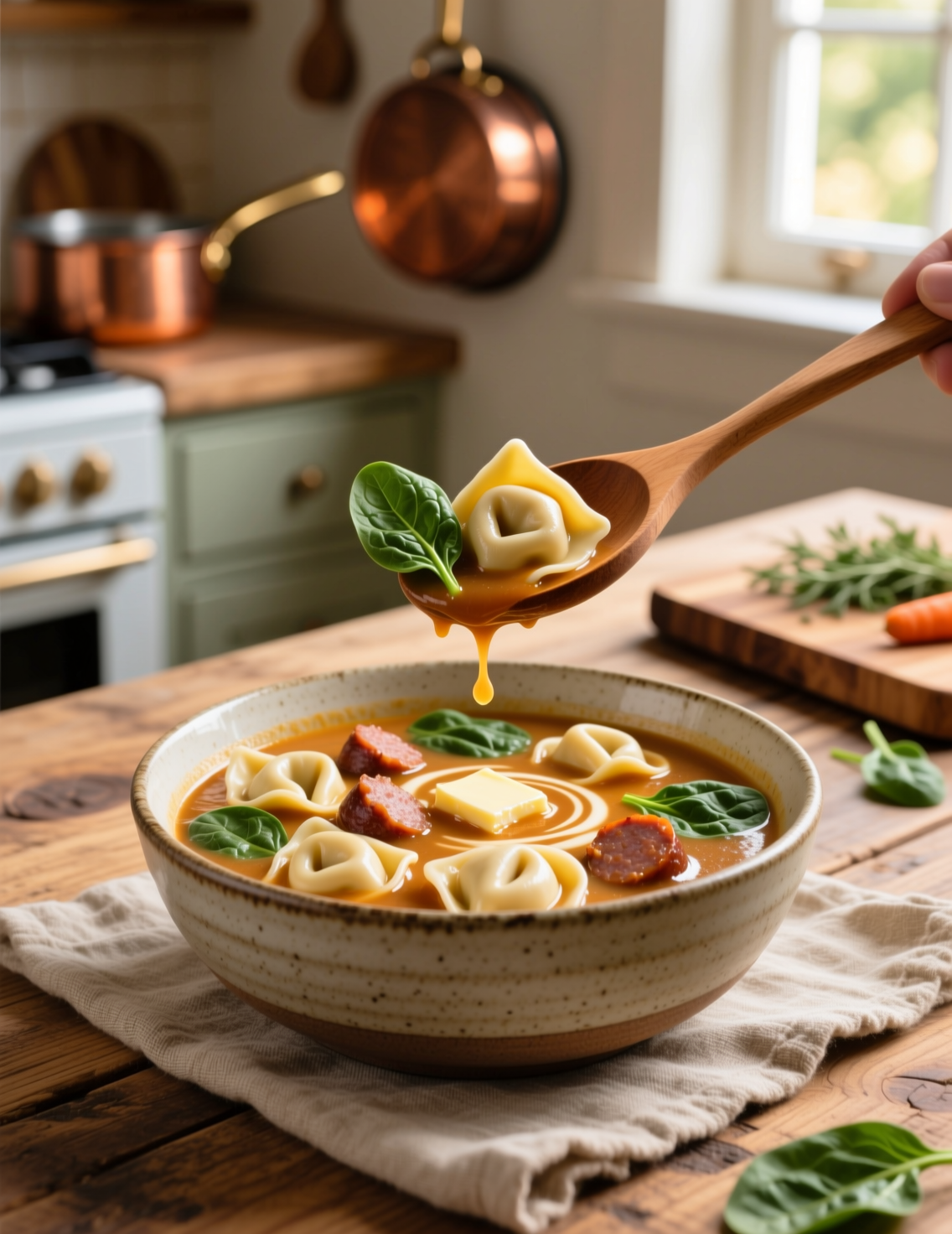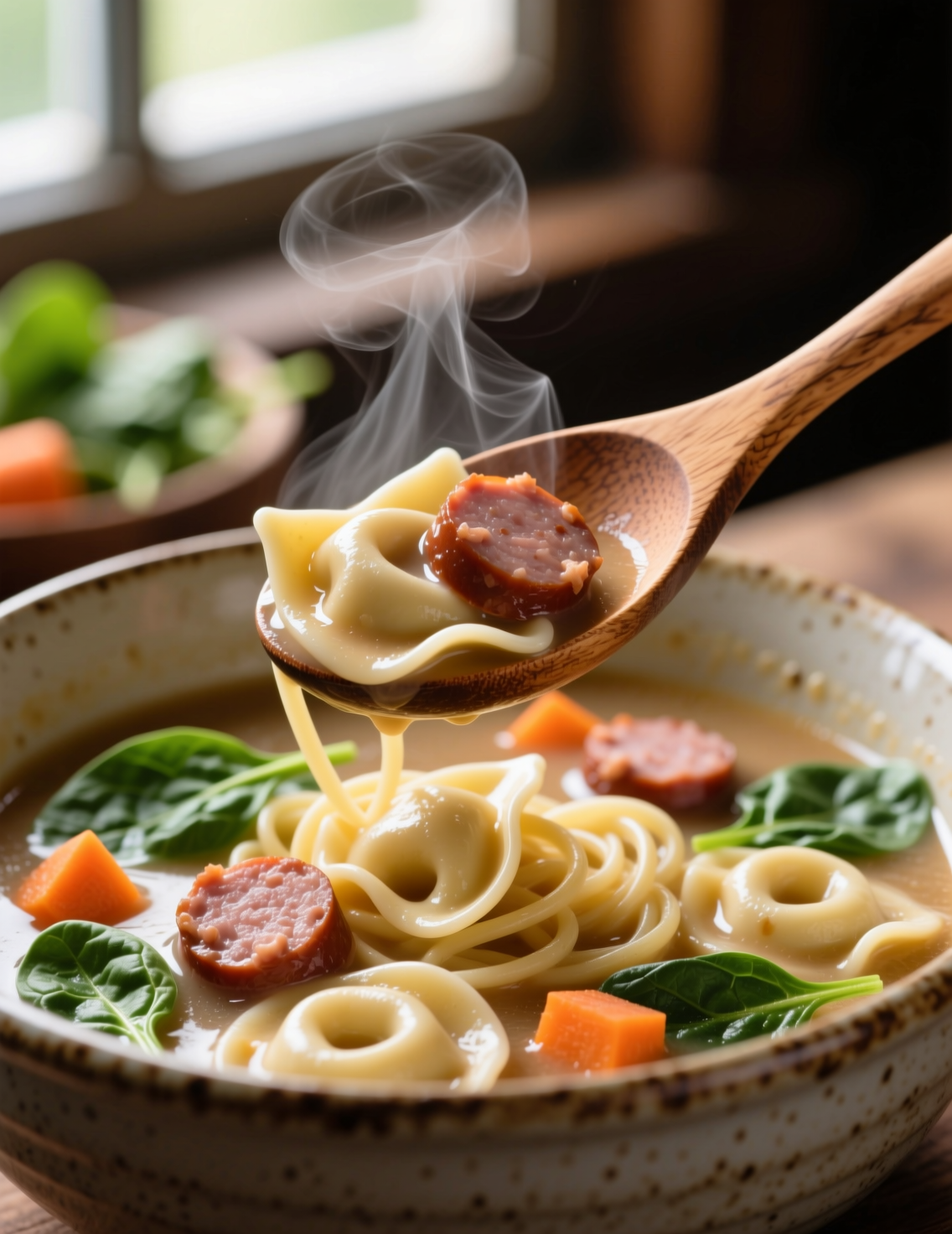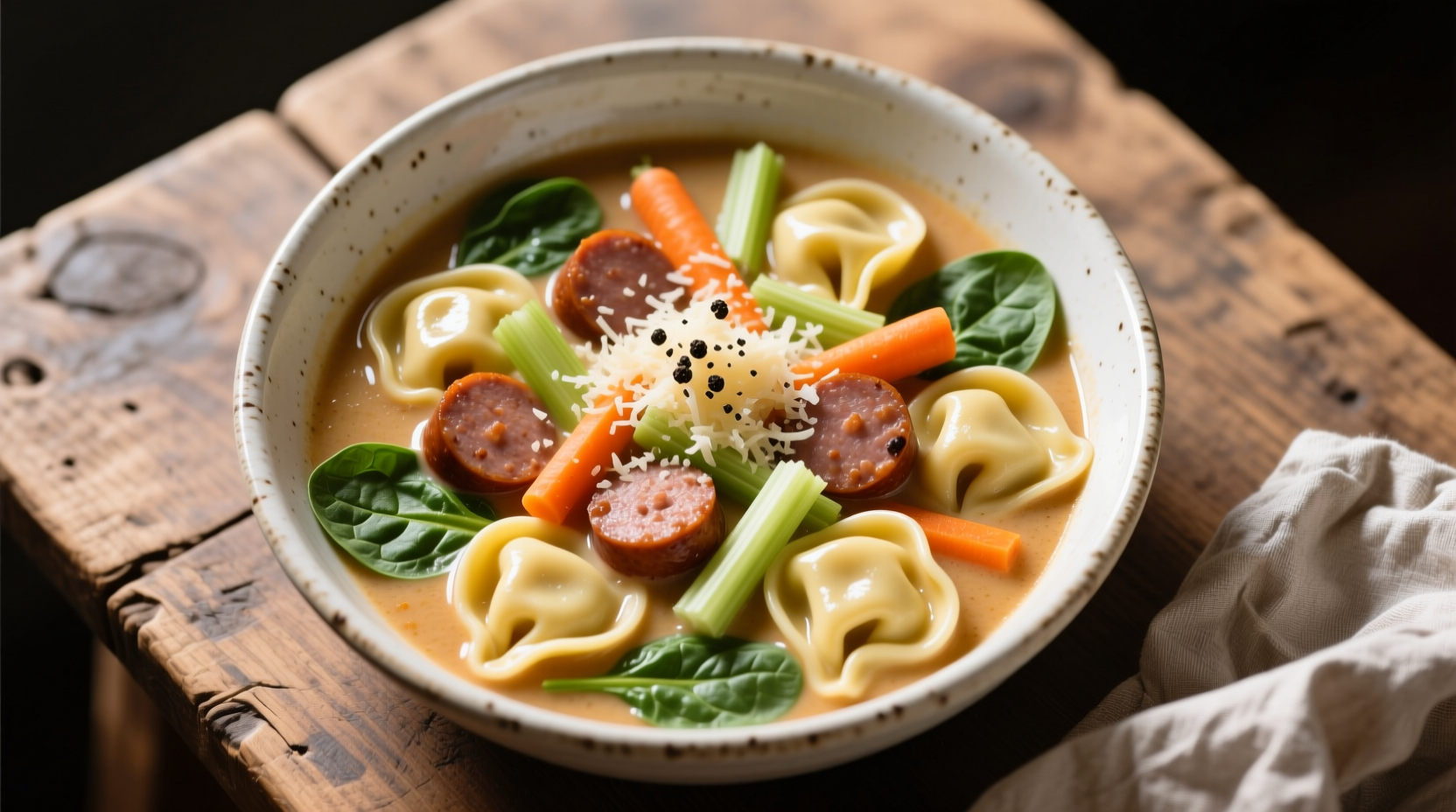There’s something quietly powerful about a slow cooker soup that simmers for hours without fuss. A pot that demands so little yet delivers so much flavor is, in a way, culinary magic. The Slow Cooker Creamy Tortellini and Sausage Soup is a fine example of this—rustic, hearty, deeply comforting. It’s not just a weeknight family meal. It’s a dish that professional chefs, caterers, and advanced home cooks can learn from when it comes to layering flavors, balancing fat, and managing textures in a low-and-slow environment.
Why This Soup Works
Italian sausage, with its fat and seasoning, anchors the flavor base. Tortellini, filled with cheese or meat, adds richness and body. A creamy broth brings them together, creating a balance between umami, fat, and dairy sweetness. The slow cooker itself makes this possible by extracting flavor gently without scorching dairy or overcooking pasta—two pitfalls when not handled carefully.
Professionally speaking, the strength of this soup lies in patience. Heat is never forced; instead, it coaxes out every aromatic nuance from onion, garlic, carrots, and celery. The sausage fat, when allowed to meld with cream, doesn’t just flavor—it emulsifies the broth into a silky consistency. Chefs know this emulsification is what separates a soup that’s just good from one that’s extraordinary.
Ingredients and Key Ratios
For six servings, professionals often work in ratios instead of just cups and spoons. The standard proportion for a balanced creamy soup here is 1 part protein, 1 part vegetables, 1 part pasta, to 2 parts liquid. This ensures that no element overwhelms another.
- 1 lb Italian sausage (mild or hot depending on preference)
- 1 medium onion, diced fine
- 2 carrots, peeled and chopped
- 2 celery stalks, chopped small
- 4 cloves garlic, minced
- 4 cups low-sodium chicken broth (always low sodium, professionals want control)
- 2 cups heavy cream (some prefer half-and-half, but cream stands better under long heat)
- 20 oz cheese tortellini, refrigerated kind, not dried
- 2 cups spinach, added late for color and freshness
- 1 tsp dried basil, 1 tsp oregano, ½ tsp thyme
- Salt and cracked pepper, adjusted carefully at the end
Notice that the ratio of broth to cream here is 2:1. That is intentional. It keeps the soup rich but not cloying. Professionals often remind students that cream is a finishing fat, not a primary cooking liquid.
Building Flavor: A Professional’s Approach
Most amateur cooks dump everything in the slow cooker and hope for the best. That’s the wrong approach. If you want depth, you need to brown the sausage first. Browning develops Maillard reactions that cannot be achieved in the slow cooker’s moist environment. A deglaze with a splash of broth lifts fond from the pan, ensuring every caramelized particle makes it into the pot.
Vegetables deserve the same respect. Sautéing onion, carrots, and celery with garlic before transferring them to the slow cooker changes the broth entirely. They sweeten, soften, and build a base flavor so that by the time cream is introduced, it blends into complexity rather than floating blandly.
This one small step—pre-browning—is the difference between soup that tastes flat after six hours and soup that people remember for years.

Managing the Dairy
A common question among professionals: how do you keep cream from splitting in the slow cooker? The answer is temperature and timing. Dairy breaks when proteins coagulate too fast. To prevent this, don’t add cream until the last 30–40 minutes of cooking. This ensures it warms gently but doesn’t overheat.
There’s also science here. Cream, because of its fat percentage, resists curdling more than milk or half-and-half. That’s why many kitchens choose it even when looking for a lighter soup. Stability is worth the slight heaviness, and a finishing touch of fresh spinach cuts through any excess richness anyway.
Tortellini Texture
Another frequent pitfall: mushy pasta. In professional kitchens, pasta is always treated as its own ingredient, not just filler. Tortellini, being delicate and cheese-filled, should be added near the end—usually in the final 20–30 minutes. If you add it earlier, the pasta bursts, the filling seeps, and you end up with a starchy broth instead of defined pasta pieces floating in cream.
The trick is watching for doneness. Tortellini should be tender but still hold shape. That moment of doneness passes quickly, and it’s the cook’s job to catch it.
Variations and Professional Tweaks
Chefs often adjust this soup depending on season, client, or plating style. For instance:
- For catering: swap spinach with kale, which holds better in reheating conditions.
- For lighter menus: use turkey sausage and a mix of broth and evaporated milk instead of heavy cream.
- For elevated service: garnish with shaved Parmigiano-Reggiano and drizzle of truffle oil.
Another pro-level move: infuse the cream with herbs before adding. Warm the cream gently with basil and thyme, then strain. This adds perfume to the broth without leaving floating herb fragments.
Slow Cooker as a Professional Tool
In high-end kitchens, slow cookers are often dismissed as “home gadgets,” but that’s short-sighted. Their controlled, consistent low heat is ideal for holding sauces or cooking proteins evenly. For a soup like this, the slow cooker eliminates guesswork. It maintains temperature in the sweet zone where flavors build slowly without scorching.
Consider this: in a 2019 survey of professional catering kitchens, nearly 42% admitted to using slow cookers or similar low-temp devices during high-volume service. That’s proof this tool isn’t just home-friendly—it’s service-friendly.
Common Mistakes to Avoid
- Over-seasoning early. Sausage already carries salt. Always season only after cream and tortellini are in.
- Using dried tortellini. It doesn’t hydrate properly in cream-based broth and leaves the soup chalky.
- Skipping deglazing. Those browned bits are concentrated flavor bombs.
- Adding spinach too soon. You’ll end up with swampy, overcooked greens instead of fresh speckles of green.
Nutrition and Balance
For professionals designing menus, balance matters as much as flavor. One serving of this soup comes in around 550–600 calories, depending on sausage fat content. Protein sits at roughly 20–25g per serving. It’s filling but not overwhelmingly heavy, especially when served with a crisp salad.
Pairing is also worth noting. A soup this rich works best with acidic wines—Pinot Grigio or Sauvignon Blanc—or with sparkling water if non-alcoholic. The acidity balances creaminess, allowing the palate to reset between bites.
A Note on Storage and Service
This soup doesn’t hold perfectly because pasta absorbs liquid over time. If planning ahead, professionals cook tortellini separately and add to the broth at service. The broth itself—without pasta—stores well for 3–4 days in refrigeration. Cream holds stable because of the fat ratio, so separation is minimal after reheating.
For large-scale service, a Bain-Marie setup with gentle stirring prevents pasta from sticking. Always keep temperature above 140°F to stay food-safe, especially with dairy involved.
Emerging Trends
Interestingly, creamy tortellini soups are finding their way into meal-delivery services. Consumers want comfort foods that travel well. Slow cooker-based recipes like this one adapt beautifully because they maintain flavor over time. With the growing demand for heat-and-eat meals, understanding soups like this is a competitive advantage for food businesses.
Plant-based alternatives are also rising. Some chefs substitute coconut milk and vegan sausage. The texture differs slightly—coconut fat separates faster—but with stabilizers like cashew cream, you can mimic the mouthfeel surprisingly well.

Step-by-Step Professional Timeline
- Brown sausage in skillet, remove, deglaze with splash of broth.
- Sauté onions, carrots, celery, garlic until translucent.
- Add sausage, vegetables, broth, and dried herbs into slow cooker. Cook low 6 hours or high 3 hours.
- Stir in cream during final 40 minutes.
- Add tortellini last 20–30 minutes. Watch closely for doneness.
- Stir in spinach just before serving. Adjust salt and pepper.
That’s the sequence that professionals follow. Each addition is strategic, designed to protect the texture and flavor integrity of every ingredient.
Conclusion
Slow Cooker Creamy Tortellini and Sausage Soup is more than a cozy meal. It’s a masterclass in balance—fat with acid, protein with starch, heat with patience. Professionals who study this recipe learn lessons that apply far beyond one dish: how to handle dairy under heat, how to time pasta, how to extract maximum flavor from sausage fat and vegetables.
For chefs, it’s also proof that simple tools can produce complex results. And for the diner, well, it’s just a bowl of pure comfort—creamy, savory, filling, and quietly luxurious.
FAQs
Can I use dried tortellini instead of fresh?
Fresh or refrigerated tortellini is best because dried versions turn chalky and don’t cook evenly in creamy broth.
When should I add the cream to the soup?
Add cream in the last 30–40 minutes to prevent curdling and keep it smooth.
How do I stop the tortellini from getting mushy?
Add it in the final 20–30 minutes of cooking and watch closely for doneness.
Can I make this soup ahead of time?
Yes, but store the broth separately and add tortellini just before serving.
What’s the best sausage to use?
Italian sausage, mild or hot, works best because it adds fat and seasoning.
How long does the soup last in the fridge?
Without tortellini, it holds for 3–4 days; with pasta, eat within 2 days.
Can I freeze this soup?
Freeze only the broth and sausage base; cream and tortellini don’t freeze well.
Is there a lighter version of this soup?
Yes, use turkey sausage and evaporated milk instead of heavy cream.
Can I replace spinach with another green?
Yes, kale or Swiss chard are sturdier options that reheat better.
What wine pairs well with this soup?
Crisp white wines like Pinot Grigio or Sauvignon Blanc balance the creaminess.

Mariana is a passionate home cook who creates delicious, easy-to-follow recipes for busy people. From energizing breakfasts to satisfying dinners and indulgent desserts, her dishes are designed to fuel both your body and hustle.
When she’s not in the kitchen, she’s exploring new flavors and dreaming up her next recipe to share with the Foodie Hustle community.

